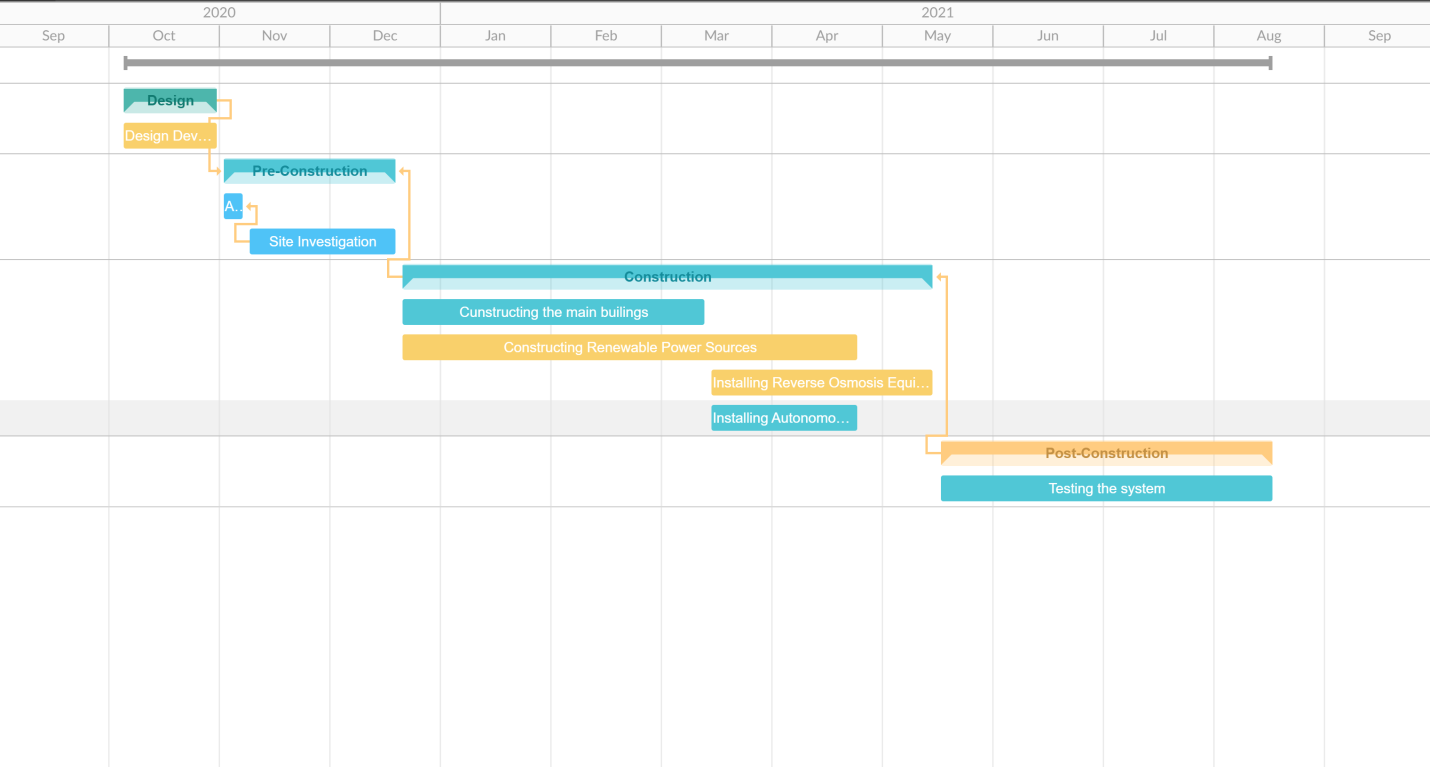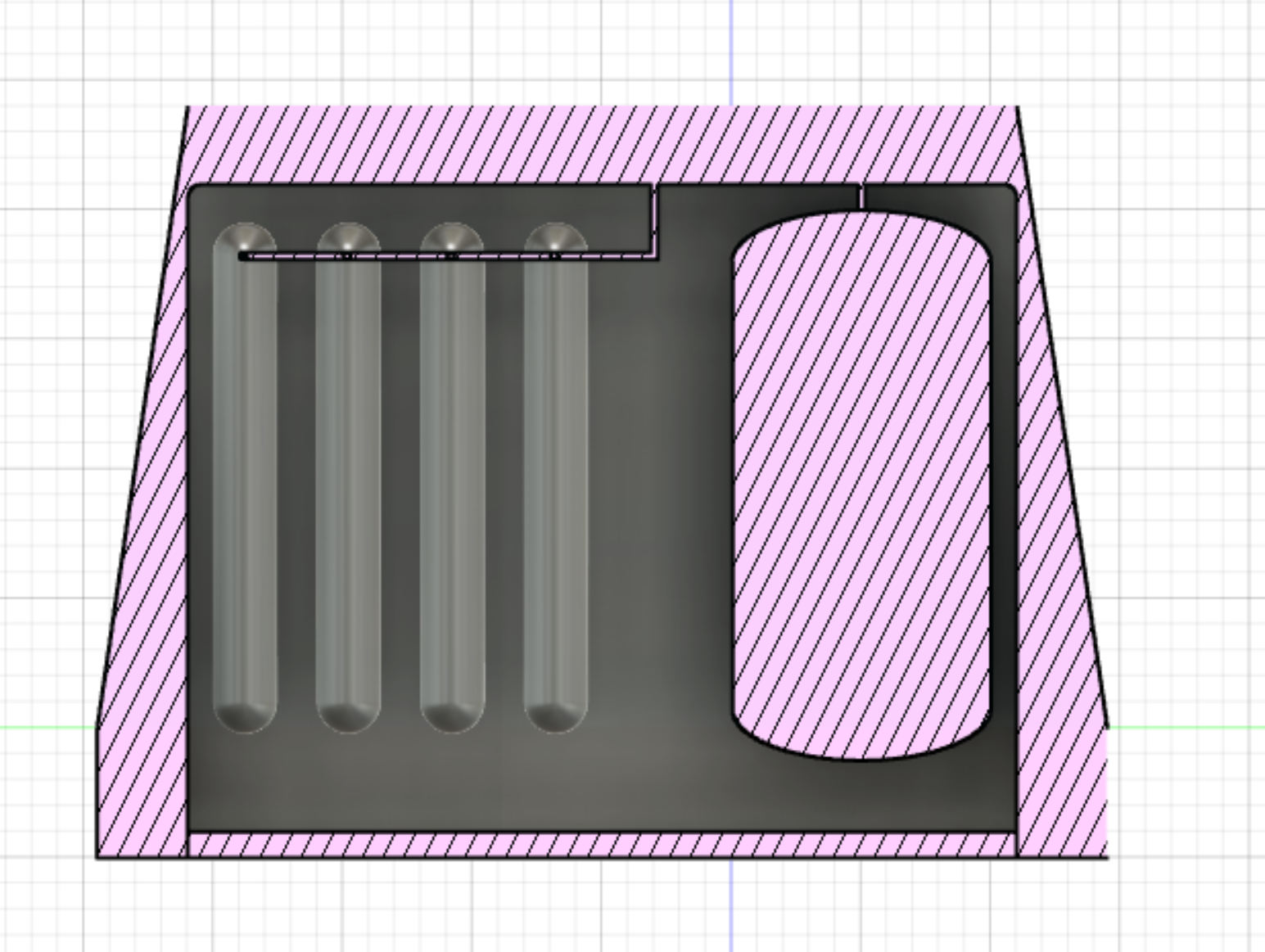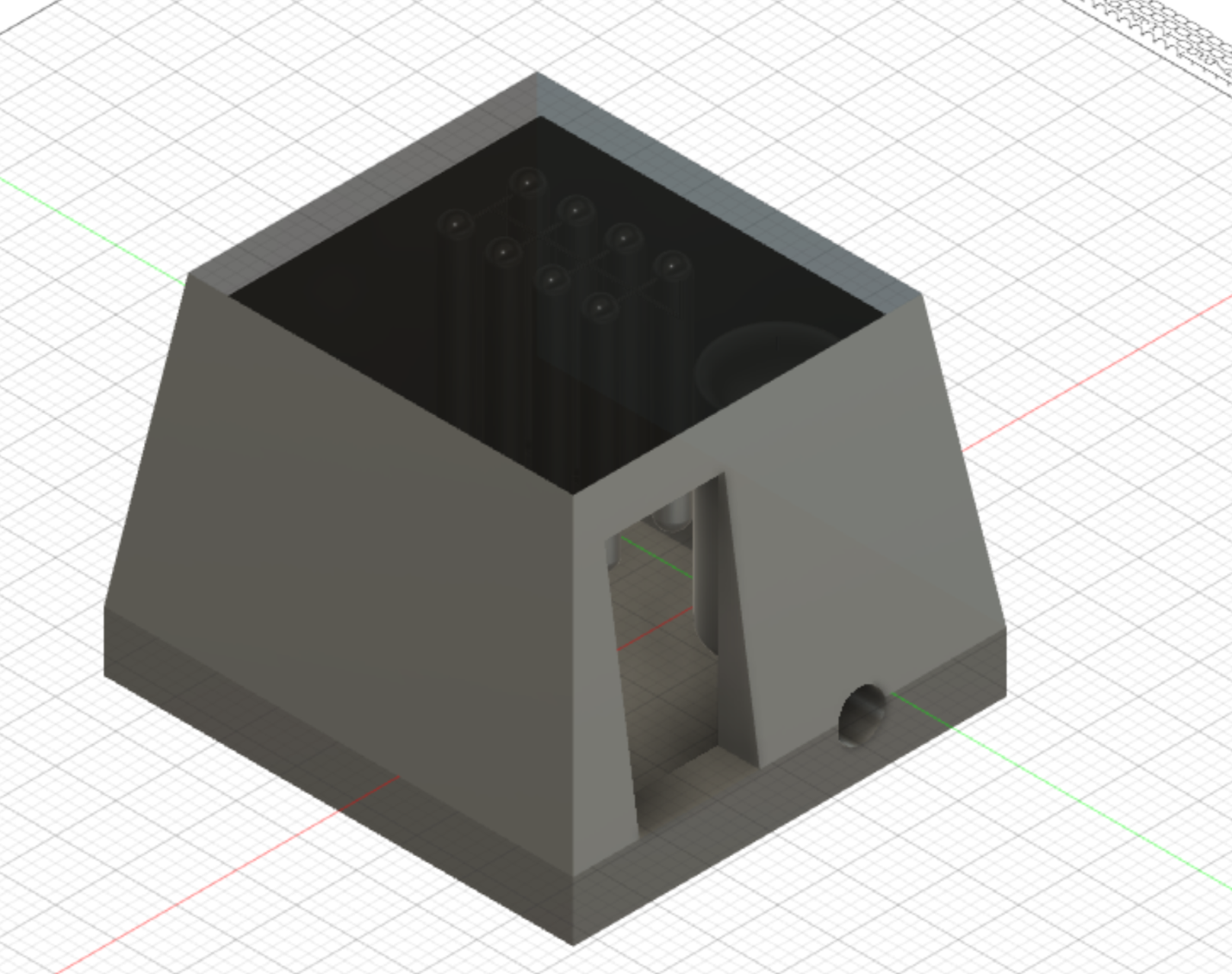This project aims to provide a detailed plan for the implementation of saline water treatment technology in bores of Cape York, Queensland, as part of the 2020 EWB challenge. Engineers without Borders partners with Australian and New Zealand universities to motivate students to participate in the annual EWB Challenges. In 2020, the Challenge sets out to tackle the issues of the Cape York area. Its main goal is to provide a sustainable living for Cape York local communities, including Indigenous people (EWB Challenge design brief, 2020). Cape York area has 15 catchment regions that provide water to the population (‘Cape York water atlas’, 2019). However, bores collecting water from underground sources began to pump out more saline water and could no longer provide local communities (Design Area 5: water management, 2020). Therefore, the population of regions where bores are the primary source of freshwater needs to introduce saline water purification technology. Installation of reverse osmosis desalination plants is recommended as a cost-effective solution that would address the needs of the population. The risk analysis of the projects also revealed some valuable safety considerations that are outlined in the corresponding section of the report.
Introduction
The following report is a development of a design challenge within the 2020 EWB challenge in partnership with the Centre for Appropriate Technology. The EWB program is an educational initiative to support the development of engineering thinking among students in Australia and New Zealand. Since 2007, when the first EWB Challenge started, more than 100,000 students took part in EWB Australia’s engineering educational programs (Over ten years of engineering education, 2020). The main goal of the EWB Challenge is to provide students with the opportunity to develop engineering skills through engaging with authentic, real-world projects aimed at introducing positive change in communities. The 2020 EWB Challenge works in partnership with the Center for Appropriate Technology. CfAT non-profit organization supports Australian communities and Traditional Owners who live in Cape York and other remote regions (Our Story, 2020).
The EWB challenge this year is set in the Cape York region. This design brief will focus on the Water treatment system project for saline bores in Design Area 5: Water Management (Design Area 5: water management, 2020). The main premise of the project is that a significant part of Cape York relies on boreholes to access artesian water. An increasing number of these bores have recently been putting out saline water that cannot be used for drinking or agriculture. The purpose of the project is to develop a cost-effective solution to the issue of water treatment in this area. It is also preferable to find an approach that would use locally sourced materials for most of the necessary equipment.
The Cape York region is a sparsely populated area of Far North Queensland with a unique climate, geography, and culture. It has 15 catchment regions covering almost the entire area of the peninsula and managing the surface waters. Part of Traditional Owners’ culture is respect for land and water, which helps preserve high biodiversity and vast, relatively untouched landscapes. Flow regimes in many catchments are undisturbed, with many river systems and wetlands remaining in pristine condition (‘Cape York water atlas’, 2019). Cape York has a few urban and community centers, mining, grazing, agriculture, and tourism activities.
Water supply in the region is legally regulated by the state Water Act 2000, which sets out water management plans (‘Cape York water atlas’, 2019). The latest government initiative is the Great Artesian Basin and Other Regional Aquifers Water Plan 2017, developed following the mentioned law. Notably, this plan regulates groundwater management across the Great Artesian Basin and groundwater linked to it, which extends into the Cape York area. Cape York has a tropical climate with distinct wet and dry seasons. The eastern Cape York region’s topography is steeper, so run flow is fast in this region. The peninsula’s western side is flat with dry savanna woodlands, the current is slow, which leads to more filtration of water in the soil and underground aquifers. It should also be noted that the Australian government recently officially returned the land, which had never been transferred to the Indigenous communities.
Solar-powered bores constitute the primary source of freshwater for the central water supply system in remote indigenous communities. Water from bores provides the population with water for domestic purposes and private agricultural use – for example, for watering trees or giving water to livestock. Recently, bores have been pumping increasingly saline water in some areas (Design Area 5: water management, 2020). Therefore, local communities are in dire need of a project that will offer inexpensive water treatment mechanisms that will purify saline water to meet drinking water standards. The water purification system for saline bores has good potential; in addition, the need for such a system is critical.
Current Challenges in The Community
Cape York, among other remote communities in Australia, is dependent on water for many aspects of local life. In addition to the regular cases of water usage, such as showering, cooking, washing hands, and clothes, Indigenous people employ water in ways that might seem wasteful to urban dwellers. Due to the fact that water consumption in these areas could reach as much as 4000 liters per person per day, the government has been implementing measures to restrict it (Beal, 2017). This is understandable, as desalinating and transporting water to a distant part of the country is expensive and often not environmentally friendly. However, there are several reasons why drastically reducing water consumption in the region is not a feasible solution to this issue.
The vast majority of water consumption in Cape York can be classified as outdoor use, which might seem unnecessary to people unfamiliar with some peculiarities of the local lifestyle. First of all, water is used for cooling house roofs and driveways, which is indispensable for the well-being of the population (Beal, 2017). Another crucial task that requires water is managing the dust from dirt roads, which are extremely common in the region (Beal, 2017). Private agricultural endeavors also consume a large amount of water due to the challenging Australian climate. Finally, water is involved in numerous local traditions, social gatherings, funeral procedures, and other culturally significant events. Although some of the issues that are currently increasing water consumption could be addressed by utilizing modern technologies, such as air conditioning and asphalt roads, the region would still require a dependable supply of water.
As mentioned above, these territories have a substantial number of bores that pump saline water. Consequently, the most probable solution is to install purification filters based on existing bores and pumping stations. This idea meets the criterion of simplicity and aesthetics, implied as necessary criteria for a successful project within the EWB Challenge. Furthermore, the installation of filters will help to supply clean water during the rainy and flood seasons and the dry season. Since flooding occurs in the region regularly, the existing well systems have been designed with this in mind. One of the aesthetic and straightforward solutions for saline water purification can be the installation of membrane filters.
Stakeholder Management Plan
Providing the population with fresh and drinking water is essential for all community members. As the water is now becoming more saline and unsuitable for serving needs, there is an immediate need to install purifying systems. The initial stakeholder identification from the project brief provides some insight into the parties involved, their capabilities, and their interest in the project.
Table 1: Stakeholder initial identification.
Now it is necessary to develop a more detailed stakeholder management plan, covering the role of each party, their goals, communication strategies, and other crucial information. As identified before, the main stakeholders are the Queensland Water Authority, Indigenous people, and other Australians working in the mining, tourism, and agriculture sectors. The Queensland Water authority is the organization that currently manages the water plan for the territory. Although it is interested in providing stable access to water resources for all Cape York residents, their vision involves limiting water usage, rather than desalinating more of the water that is pumped from numerous bores in the region (Water plan, 2020). Queensland Water authority could have a substantial influence on the project; however, it seems that its interest does not align with the direction of this proposal.
The Traditional owner community has a high interest in this project, as access to large amounts of water is crucial to many aspects of the local lifestyle and tradition. Logically, installing water treatment plants is a more appealing alternative to water access restrictions, used by local governments. Their influence at the initial stages of the project is minimal; however, Indigenous people could help test and maintain the water filtering facilities after they are constructed.
The third stakeholder also has a high interest in this project, as their activities are directly dependent on water. This group of people would likely benefit financially from the desalination stations, as their businesses will be able to operate at a higher level of efficiency. Similar to the indigenous people, they will be able to assist in operating and maintaining water treatment plants. They are also likely to be able to invest money and resources into the project, as it will give them a substantial return.
Table 2: Stakeholder management.
Requirement Analysis
Based on the analysis of the goals and possible contributions of the main stakeholders and the available geological data on the Cape York area, here are 10 technically feasible requirements for the desalination plants.
- Water desalination mechanisms must be scalable to fit different use cases without wasting resources.
- Desalination plants should be designed in a way that would allow people to service them without excessive risk.
- Desalination plants should use the reverse osmosis filtering technology as it is the most energy-efficient.
- Desalination plants should use the most recent membranes to ensure maximum efficiency and reliability.
- Desalination plants should use wind or solar power to supply at least 50% of their energy.
- Desalination plants should have batteries with enough capacity to sustain 24 hours of operation.
- Desalination plants should have diesel generators with enough power to sustain operation in case of a power outage.
- Desalination plants should have autonomous power management systems that would engage reserve diesel generators if the battery is below 20%.
- Desalination plants placed in residential areas should have noise levels below 70 decibels at a distance of 50 meters.
- Desalination plants should use locally sourced materials where possible in their construction.
Conceptual Design Selection
Only the concept screening matrix will be used for conceptual design selection for this project, as utilizing the Pugh matrix or the SWOT matrix would not provide any additional insight. The main concept of this project is more environmentally friendly than the current solution and offers reliable, uninterrupted access to water, which is the best way to satisfy the requirements of the population. The main downside of the system is the upfront investment required to install it. The current solution is less sustainable due to the power sources used. It also does not allow for unrestricted water use, which is critical to the indigenous communities. The main advantage of the system is that it is already implemented. The alternative solution offers superior sustainability with the lowest cost of implementation and operation. However, it cannot be considered a viable replacement to the other options, as it severely limits water use.
Table 3: Concept Screening.
Cost/Benefit Analysis
Table 4: Cost/benefit analysis.

Implementation
Outcomes of Risk Analysis
This section contains the conclusions drawn from the detailed risk analysis that can be found in the corresponding appendix. To ensure safe operation, the plants should have well-insulated watertight enclosures for their electronics, and be serviced regularly and meticulously. The daily operation should be automated to minimize human error, and any maintenance work should be assessed by quality-control personnel. The outside construction of the plants should be able to withstand seasonal floods and occasional earthquakes.
Gantt Chart of Implementation Schedule.

Reference List
Beal, C. (2017) ‘Some remote Australian communities have drinking water for only nine hours a day’, The Conversation, Web.
‘Cape York water atlas’ (2019) EWB. Web.
Design Area 5: water management (2020) EWB Challenge. Web.
EWB Challenge design brief (2020) EWB Challenge. Web.
Great Artesian Basin and other regional aquifers water plan (2020) Business Queensland. Web.
Our Story (2020) Centre for Appropriate Technology. Web.
Over ten years of engineering education (2020) EWB Challenge. Web.
Appendix A
Risk Analysis
This detailed risk analysis will consist of two parts: risk identification and risk analysis. The proposed water desalination system project has three main aspects that could introduce risks: hardware, people, and natural disasters. One of the main hazards in reverse osmosis desalination plants originates from the high voltage equipment located near large tanks of water. In case of leaks or ruptures, short circuits could occur, causing fires, which would damage equipment and endanger maintenance personnel. High-pressure water vessels also have inherent risks, especially as their seals and connectors deteriorate with age. Another issue is human error, which could compromise the risk-mitigating effects of servicing the desalination station. Finally, natural disasters such as floods, earthquakes, and fires could have unpredictable effects on the operation of water treatment plants.
Further evaluating the aforementioned risks shows some ways to minimize their likelihood or potential impact. The possible issues with high-pressure water and high voltage electronic equipment can be averted by designing watertight enclosures for the important components and maintaining them by replacing gaskets and seals. Unfortunately, human error cannot be eliminated from a system that requires manual servicing; however, there are two ways in which it can be minimized. First, the daily operation of the desalination plants should be autonomously controlled and monitored by the on-board computers. Second, maintenance personnel should require permits to work on the facilities, and all completed operations should be quality-checked by specially trained employees. As for natural disasters, the Cape York region is known to have frequent floods, as well as some earthquakes of moderate intensity. Consequently, water desalination plants should be designed to withstand these dangers. These disasters could also damage the power lines coming to the buildings, in which case the reserve power generators and batteries would maintain water access until power infrastructure is restored.
Appendix B
Detailed drawings of the design


